

Mary Holmes
Creating Critical Thinkers Through Media Literacy: Andrea Quijada at TEDxABQED. Youtube. YouTube. The Urban-Education Stigma and School Segregation. As a growing body of research suggests, however, test scores don’t truly measure school quality.
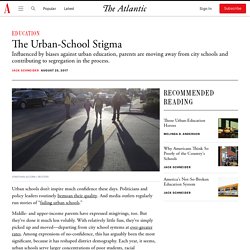
And, if that is the case, chances are the greatest threat to urban schools isn’t a flaw in the design or execution of urban education. Instead, it is a self-fulfilling prophecy—one in which privileged families presume city schools to be failing and, in taking flight from them, bring about a real decline. The Condition of Education - Preprimary, Elementary, and Secondary Education - High School Completion - Public High School Graduation Rates - Indicator May (2020) In school year 2017–18, the national adjusted cohort graduation rate (ACGR) for public high school students was 85 percent, the highest it has been since the rate was first measured in 2010–11.
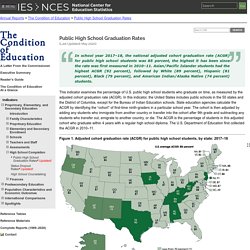
Asian/Pacific Islander students had the highest ACGR (92 percent), followed by White (89 percent), Hispanic (81 percent), Black (79 percent), and American Indian/Alaska Native (74 percent) students. This indicator examines the percentage of U.S. public high school students who graduate on time, as measured by the adjusted cohort graduation rate (ACGR). In this indicator, the United States includes public schools in the 50 states and the District of Columbia, except for the Bureau of Indian Education schools.
State education agencies calculate the ACGR by identifying the “cohort” of first-time ninth-graders in a particular school year. Using Critical Literacy as a Teaching Tool in Early Elementary Grades. From the back of her class, I watched as one of my favorite colleagues read to her second-grade students.

While reading, she paused, allowed for turn and talks, and asked students to make predictions. When she had finished reading, my colleague asked questions about the plot, setting, and character traits. In many respects, the lesson was a success—the students had participated eagerly. Kimberly Noble: How does income affect childhood brain development? Identity Development for Teens of Color. Developing a Racial Identity Exploring the question, “Who am I?”

Can be one of the most exciting features of adolescence. Youth build their personal identity based, in part, on messages they receive from others about who they are in the present, and who they can or should be in the future. Seeing how other teens “like them” act in school or are represented in popular media can also shape how youth see themselves. While youth are figuring out their personal identity, they are also developing an understanding of themselves in relation to different social groups.
Diverse and Inclusive Books to Inspire Young Adults. By the time readers are young adults, their worlds have broadened to include a wide range of people and life experiences that inform their developing identities. As teenage readers discover who they are, it's important that they have access to stories that reflect and celebrate the full range of human experiences and a diversity of race, ethnicity, sexual orientation, gender identity, physical and mental abilities, religion, and culture.
The following topics and themes are explored in this list: For even more Scholastic books that explore these themes, check out our catalog, The Power of Story: Diverse Books for All Readers. Teen Fiction: Books for Teen Boys. 35 Books for Teens - Young Adult Books Every Girl Should Read. Books can take you anywhere.

They have the extraordinary ability to take us to different worlds through the eyes and thoughts of a main character or narrator. Their experiences so feel real as we read on to see what happens next. Some leave you thinking about what just happened, inspire you in your own life in different ways and help you deal with heavy topics. Others can teach you about the world around you, but books can also just be a fun way to pass the time. This content is imported from {embed-name}. Letters: Code-Switching in the Classroom. Updated on April 30, 2018 In The Atlantic’s April issue, William Brennan wrote about Julie Washington, a speech pathologist who believes that helping kids switch seamlessly between dialects is a key to their success.
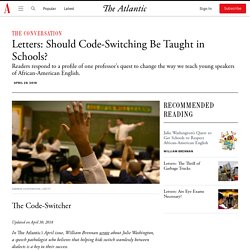
I read “The Code-Switcher” in the April issue of The Atlantic with horror. Julie Washington’s Quest to Get Schools to Respect African-American English. The social effects of this type of classroom environment have been acknowledged for decades, but what’s come to concern researchers more recently is the extent to which dialect differences between student and teacher increase the student’s cognitive load.
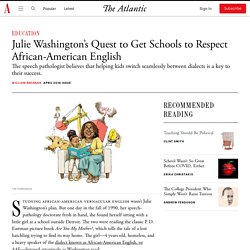
“What does it do to your response times when you have to stop and interpret something before you can move on? ,” Washington asks. Kandice Sumner: How America's public schools keep kids in poverty. Why Is Teen Identity Development Important? - Aspiro Wilderness Adventure Therapy. Though it can be hard for parents to let go and acknowledge their teen needs external help, a credible adventure therapy program can relatively quickly and positively change your son or daughter’s life for the better.
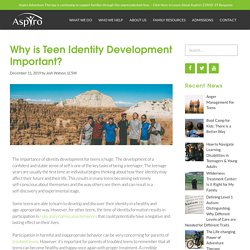
Psychologist Erik Erikson advocated that teen identity development is fostered by experiences that allow individuals to express their individuality and receive feedback and validation from others. Adventure therapy programs provide experiences that promote healthier relationships and positive identity formation in teens.